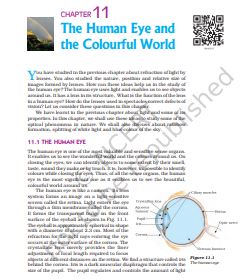‘NCERT Solutions for Class 10 Science Chapter 11‘ PDF Quick download link is given at the bottom of this article. You can see the PDF demo, size of the PDF, page numbers, and direct download Free PDF of ‘Ncert Class 10 Science Chapter 11 Exercise Solution’ using the download button.
NCERT Class 10 Science Textbook Chapter 11 With Answer PDF Free Download

Chapter 11: The Human Eye and Colorful
You have studied in the previous chapter the refraction of light by lenses. You also studied the nature, position, and relative size of images formed by lenses. How can these ideas help us in the study of the human eye?
The human eye uses light and enables us to see objects around us. It has a lens in its structure. What is the function of the lens in the human eye?
How do the lenses use in spectacles correct defects of vision? Let us consider these questions in this chapter. We have learned in the previous chapter about light and some of its properties.
In this chapter, we shall use these ideas to study some of the optical phenomena in nature. We shall also discuss rainbow the formation, the splitting of white light, and the blue color of the sky.
11.1 The Human Eye
The human eye is one of the most valuable and sensitive sense organs. It enables us to see the wonderful world and the colors around us.
By closing our eyes, we can identify objects to some extent by their smell, taste, sound they make, or by touch.
It is, however, impossible to identify colors while closing the eyes. Thus, of all the sense organs, the human eye is the most significant one as it enables us to see the beautiful, colorful world around us.
Page No: 197
Exercise
1. The human eye can focus on objects at different distances by adjusting the focal length of the eye lens. This is due to
(a) presbyopia
(b) accommodation
(c) near-sightedness
(d) far-sightedness
Answer-
(b) accommodation
Due to accommodation, the human eye can focus objects at different distances by adjusting the focal length of the eye lens.
Page No: 198
2. The human eye forms an image of an object at its
(a) cornea
(b) iris
(c) pupil
(d) retina
Answer –
(d) retina
The retina is the layer of nerve cells lining the back wall inside the eye. This layer senses light and sends signals to the brain so you can see.
3. The least distance of distinct vision for a young adult with normal vision is about
(a) 25 m
(b) 2.5 cm
(c) 25 cm
(d) 2.5 m
Answer –
(c) 25 cm
25 cm is the least distance of distinct vision for a young adult with normal vision.
4. The change in focal length of an eye lens is caused by the action of the
(a) pupil
(b) retina
(c) ciliary muscles
(d) iris
Answer-
(c) ciliary muscles
The action of the ciliary muscles changes the focal length of an eye lens
5. A person needs a lens of power -5.5 dioptres for correcting his distant vision. For correcting his near vision he needs a lens of power +1.5 dioptre. What is the focal length of the lens required for correcting (i) distant vision, and (ii) near vision?
Answer-
The power (P) of a lens of focal length f is given by the relation
Power (P) = 1/f
(i) Power of the lens (used for correcting distant vision) = – 5.5 D
Focal length of the lens (f) = 1/P
f = 1/-5.5
f = -0.181 m
The focal length of the lens (for correcting distant vision) is – 0.181 m.
(ii) Power of the lens (used for correcting near vision) = +1.5 D
Focal length of the required lens (f) = 1/P
f = 1/1.5 = +0.667 m
The focal length of the lens (for correcting near vision) is 0.667 m.
| Author | NCERT |
| Language | English |
| No. of Pages | 12 |
| PDF Size | 2.3 MB |
| Category | Science |
| Source/Credits | ncert.nic.in |
NCERT Solutions Class 10 Science Chapter 11 How do Organisms Reproduce
1. What is meant by the power of accommodation of the eye?
Answer-
The ability of the lens of the eye to adjust its focal length to clearly focus rays coming from distant as well from near objects on the retina is known as the power of accommodation of the eye.
2. A person with a myopic eye cannot see objects beyond 1.2 m distinctly. What should be the type of corrective lens used to restore proper vision?
Answer-
An individual with a myopic eye should use a concave lens of a focal length of 1.2 m so that he or she can restore proper vision.
3. What are the far points and near point of the human eye with normal vision?
Answer-
The minimum distance of the object from the eye, which can be seen distinctly without strain is called the near point of the eye. For a normal person’s eye, this distance is 25 cm.
The far point of the eye is the maximum distance to which the eye can see objects clearly. The far point of a normal person’s eye is infinity.
4. A student has difficulty reading the blackboard while sitting in the last row. What could be the defect the child is suffering from? How can it be corrected?
Answer-
The student is suffering from short-sightedness or myopia. Myopia can be corrected by the use of a concave or diverging lens of appropriate power.
The Human Eye and Colorful World NCERT Textbook With Solutions PDF Free Download
